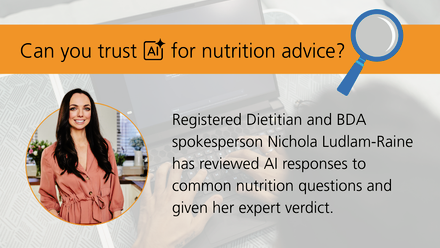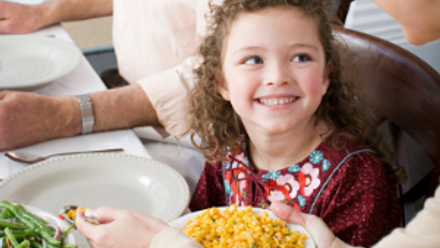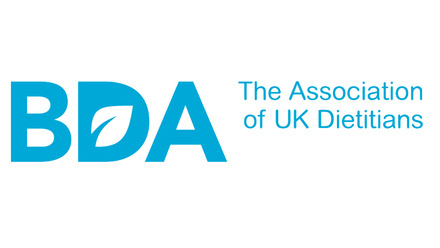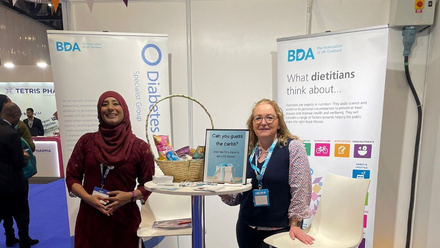Artificial intelligence is set to have a huge impact on how we practise. Three diabetes dietitians from Manchester Royal Infirmary explain how they are using it now.
Artificial intelligence (AI) has unknown potential to enhance dietetic practice. How we are using it now is only scratching the surface.
AI can support all five strategic objectives and aligns with the four golden threads of the BDA Strategic Plan. The BDA Digital Vision offers examples of how AI can be utilised by the dietetic workforce in context with other considerations for digital working. While responders to the BDA Digital Vision survey noted using AI the least in 2023, it was recognised in roundtable discussions and noted that due to the rapid progression of AI, responses to using AI may change very quickly in the near future.2 It is paramount that the dietetic workforce stay abreast of these changes.
This article provides five examples where AI has been used safely and effectively to enhance clinician experience, increase efficiency and provide greater outcomes. We hope these examples demonstrate how AI can be used to amplify the human aspect of dietetics.
Our experience of using AI in dietetic practice has shown consistent results which saved clinician time. AI can be used in a variety of ways, with the examples in this article being only a handful. Our takeaway messages are:
- The ways in which AI can be used in dietetic practice to reduce workload and create efficiencies are evolving; think outside the box to see if AI can help you with your tasks
- Always check the AI output for accuracy and correct as needed
- If unsure on security, do not enter confidential or identifiable data into the AI tool and discuss with your local IT team
We encourage all members of the dietetic workforce, in every setting, to embrace, explore and share the possibilities of AI.
1. Optimising software to support equity of access
Not unlike many services within the NHS, our service is currently managing a backlog. An approach was developed to our 700-person waiting list which ensures equity of access. Part of this approach is a patient-scoring system which translates demographic criteria into actions.
Using an Excel spreadsheet was an obvious choice for managing large amounts of data. Unfortunately our team missed the ‘Which Excel formula to use’ module in dietetic training, creating the problem: “I know this software can make this work easier, but I don’t know how to make the software do what I want it to do”.
In lieu of a software super-user being present, previous tactics to finding an answer would include using a search engine (Google or Bing), clicking through YouTube video tutorials, or scouring Microsoft help chat rooms. This approach would have taken at least a few hours and likely left us feeling frustrated and demotivated.
Enter AI (ChatGPT): we simply asked it, in language that we understand, what formula would provide our desired result, i.e. “What Excel formula can be used to make X-age range give a score of 0, Y-age range give a score of 1, and Z-age range a score of 3?”. In this example, AI allowed the effective utilisation of readily available software, enabling our team to understand the patients on our waiting list quickly and deliver equity of access.
2. Creating clinical notes and letters
In the age of video calls and meetings, it is common to use built-in software, such as Microsoft Teams, to record and transcribe meetings with a fair certainty of accuracy.
The next step is to use AI to take the recording and, with context provided, produce a summary while highlighting the important points. While this version of AI is not readily available in the NHS, using AI to create meeting minutes or clinical notes of consultations is common.
Available online AI tools for creating clinical notes and letters include Zanda Health, HeidiHealth and WriteUpp. Our experience with HeidiHealth has meant that we have been able to reduce time spent taking notes and creating letters. This means more time to build rapport, use communication skills to develop deeper understanding and interpret complex multisource data. HeidiHealth is compliant with General Data Protection Regulation and NHS regulations. This means that patient-identifiable information is handled safely and appropriately. We have found that 90% of the time, all notes and letters produced this way are accurate and appropriate. However it is still vital that the clinician reviews AI-generated outputs carefully each time.
3. Creating meal plans
There is a wealth of resources available on the internet for various medical conditions requiring nutritional input, but these resources do not always address the need.
Recently, a patient asked for an example meal plan in a specific language with traditional cultural foods. AI was asked to create a meal plan for the condition including cultural foods for this region in the specific language. The meal plan that was produced was verified using a translation app (Google Lens on Google Translate), whereby a camera can be held over the text to translate to a specific language in real time. The clinician was able to ensure that the information provided was correct and accurate, and add any additional notes that were needed in the specified language.
4. Creating images
Whilst reviewing and updating resources, a request was made to create a resource that was more accessible for people with English as a second language. The decision was made to create a picture version of written resources. Instead of searching through countless existing images on search engines, we decided to make our own images using AI.
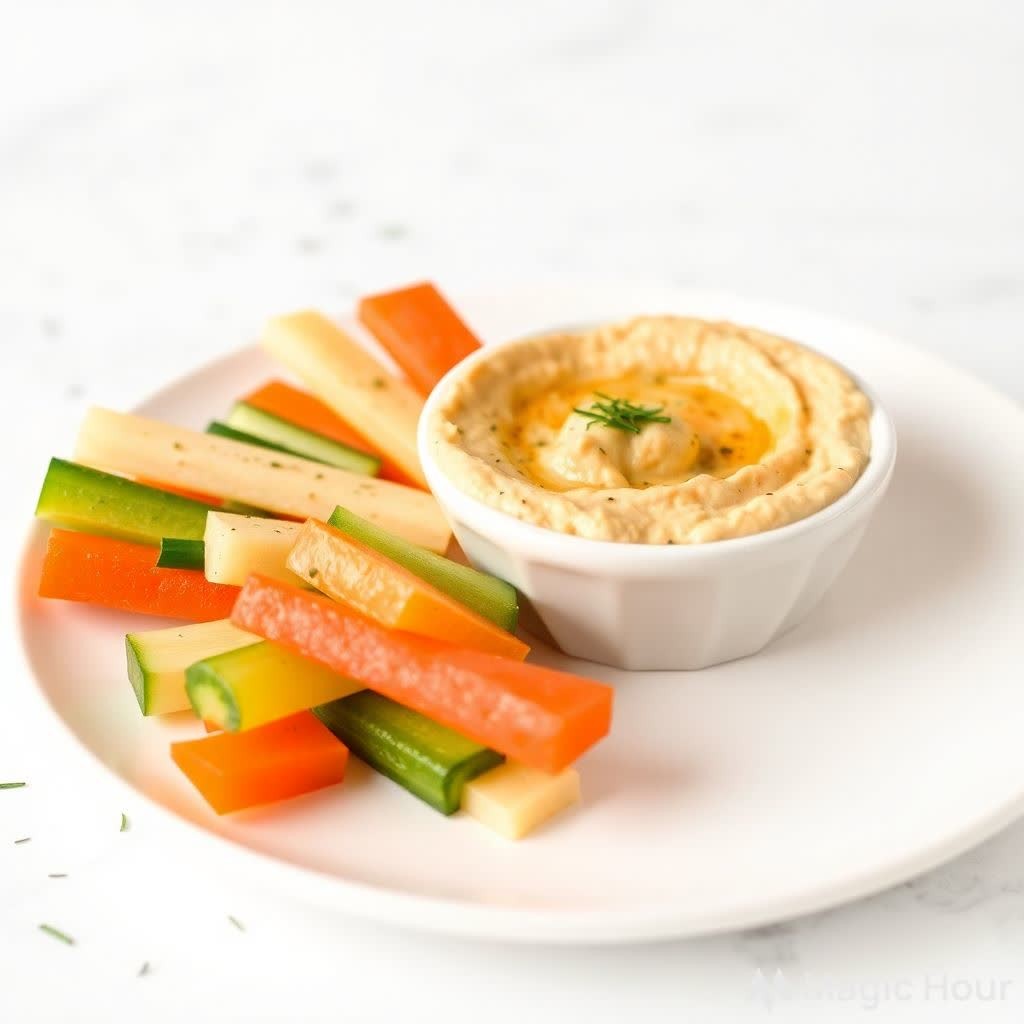
An AI tool (MagicHour) was used to create reallife images of specific foods, in specific portion sizes, with other details as needed. An example of a prompt would be “Create a photo of a portion of vegetable sticks with hummus on a white dinner plate on a white background taken from above” (see image generated). While the AI generator may take some artistic licence in adding cutlery, herbs and other non-requested items, the results are consistently usable and allow for quick and easy alterations (usually altering portion size, adjusting angle of the image or background items). The images created may not be perfect but do fulfil the brief. This is especially relevant for generating cultural foods, which may not be as readily available elsewhere.
5. Creating a leaflet
A new service was created, and a patient-facing leaflet was required to explain the service and support recruitment in the clinic rooms and waiting area. AI was used with the prompt “Make me a leaflet (two sides A4) for patients with diabetes, which advertises a new group called ‘Nourish’ which helps people with diabetes to get the most out of Mounjaro (medication). Include pictures of groups of people with diabetes at different ages, sexes and ethnicities.”
This initial prompt provided 80% usable output, and even included sections to input contact details, dates, locations and eligibility criteria. Further prompts were used to alter the images slightly (create various settings), to create images of meals from global cuisines, and to create a logo. The usable pieces were then copied into a program for organisation and printing as patient leaflets and posters (e.g. Microsoft Publisher or PowerPoint).


